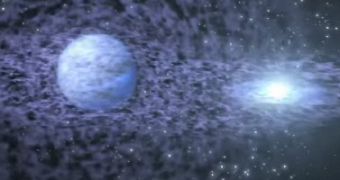Supergiant high-mass X-ray binaries, HMXB for short, are stellar systems consisting of a supergiant star and a neutron star orbiting around it. HMXBs are relatively rare in the universe and are believed to be only a short phase in the life of binary star systems. At the time when ESA's gamma-ray space observatory - Integral - was launched into space about six years ago only seven such stellar systems were known to exist. Meanwhile, Integral discovered another fifteen.
The last HMXB discovered by Integral is formed of a supergiant star with a diameter about 20 times that of the Sun, weighing about 30 solar masses and having a luminosity some one million times that of the Sun orbited by a neutron star only 15 kilometers across. The main component reaches a surface temperature of about 20,000 Kelvin. Because the system is extremely bright in X-ray and gamma-ray, the Integral observatory is able to easily spot it.
Some binaries are even surrounded by clouds of gas and dust. "They are so deeply embedded that only Integral has the sensitivity to see them", says Sylvain Chaty of the University of Paris Diderot and CEA Saclay France, part of the research team operating the Integral observatory.
Most of the time the neutron star, the remnant of a supergiant companion that originally formed the binary system, orbits around the more massive companion in the vicinity of the outer atmosphere. Although, such systems present astronomers with a unique opportunity to study massive binary systems, theory also says that there should be far less supergiant systems than Integral is currently showing, which might pose a little problem. "There must be many more of them than we thought you could have. So we don't quite know what is going on, yet", says Chaty.
Judging by the size of the systems, the neutron star must have formed about 10 million years after the binary was created. Eventually, the other more massive companion will have a fate rather similar to that of its previous supermassive sibling, turning either into a neutron star or into a black hole, thus creating a neutron star binary or a neutron star-black hole pair.
In the end, energy loss will send them spiraling towards each other to an inevitable collision that is most likely to form a black hole. As this event occurs, a massive gamma-ray burst is emitted. Further observations with the Laser Interferometer Space Antenna could even reveal the energy radiated by the objects in the form of gravitational waves as they spiral towards each other. Meanwhile, Integral is expected to find and study even more HMXBs.

 14 DAY TRIAL //
14 DAY TRIAL //